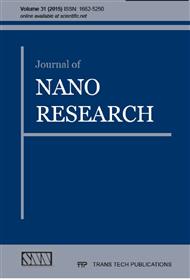[1]
Q.A. Pankhurst, J. Connolly, S.K. Jones, J. Dobson, Applications of magnetic nanoparticles in biomedicine, J. Phys. D: Appl Phys 36 (2003) R167.
DOI: 10.1088/0022-3727/36/13/201
Google Scholar
[2]
S.S. Agasti, S. Rana, M.H. Park, C.K. Kim, C.C. You, V.M. Rotello, Nanoparticles for detection and diagnosis, Adv. Drug. Deliv. Rev. 62 (2010) 316–328.
DOI: 10.1016/j.addr.2009.11.004
Google Scholar
[3]
O. Veiseh, J.W. Gunn, M.Q. Zhang, Design and fabrication of magnetic nanoparticles for targeted drug delivery and imaging, Adv. Drug. Deliv. Rev. 62 (2010) 284–304.
DOI: 10.1016/j.addr.2009.11.002
Google Scholar
[4]
C.F.D. Chan, B.K. Dmitri, Synthesis and evaluation of colloidal magnetic iron oxides for the site-specific radiofrequency-induced hyperthermia of cancer, J. Magn. Magn. Mater. 122 (1993) 374-378.
DOI: 10.1016/0304-8853(93)91113-l
Google Scholar
[5]
Z. Guandong, L. Yifeng, I. Baker, Surface engineering of core/shell iron/iron oxide nanoparticles from microemulsions for hyperthermia, Materials Science and Engineering: C 30 (2010) 92-97.
DOI: 10.1016/j.msec.2009.09.003
Google Scholar
[6]
T. Neuberger, B. Schopf, H. Hofmann, M. Hofmann, B. Vonrechenberg, Superparamagnetic nanoparticles for biomedical applications: possibilities and limitations of a new drug delivery system, J. Magn. Magn. Mater. 293 (2005) 483–496.
DOI: 10.1016/j.jmmm.2005.01.064
Google Scholar
[7]
A.K. Gupta, M. Gupta, Synthesis and surface engineering of iron oxide nanoparticles for biomedical applications, Biomaterials 26 (2005) 3995–4021.
DOI: 10.1016/j.biomaterials.2004.10.012
Google Scholar
[8]
J.P.M. Almeida, A.L. Chen, A. Foster, R. Drezek, In vivo biodistribution of nanoparticles, Nanomedicine 6 (2011) 815-835.
DOI: 10.2217/nnm.11.79
Google Scholar
[9]
S. Mornet, S. Vasseur, F. Grasset, E. Duguet, Magnetic nanoparticle design for medical diagnosis and therapy, J. Mater. Chem. 14 (2004) 2161-2175.
DOI: 10.1039/b402025a
Google Scholar
[10]
L.M. Lacava, Z.G.M. Lacava, M.F. Da Silva, O. Silva, S.B. Chaves, R.B. Azevedo, F. Pelegrini, C. Gansau, N. Buske, D. Sabolovic, Magnetic resonance of a dextran-coated magnetic fluid intravenously administered in mice, Biophys. J. 80 (2001).
DOI: 10.1016/s0006-3495(01)76217-0
Google Scholar
[11]
C.C. Berry, S. Wells, S. Charles, A.S.G. Curtis, Dextran and albumin derivatised iron oxide nanoparticles: influence on fibroblasts in vitro, Biomaterials 24 (2003) 4551-4557.
DOI: 10.1016/s0142-9612(03)00237-0
Google Scholar
[12]
A.K. Gupta, A.S. Curtis, Surface modified superparamagnetic nanoparticles for drug delivery: interaction studies with human fibroblasts in culture, J. Mater. Sci. Mater. Med. 15 (2004) 493-496.
DOI: 10.1023/b:jmsm.0000021126.32934.20
Google Scholar
[13]
A.F. Thunemann, D. Schutt, L. Kaufner, U. Pison, H. Mohwald, Maghemite Nanoparticles Protectively Coated with Poly (ethylene imine) and Poly (ethylene oxide)-b lock-poly (glutamic acid), Langmuir 22 (2006) 2351-2357.
DOI: 10.1021/la052990d
Google Scholar
[14]
C. Chouly, D. Pouliquen, I. Lucet, J.J. Jeune, P. Pellet, Development of superparamagnetic nanoparticles for MRI: effect of particle size, charge and surface nature on biodistribution, J. Microencapsulation 13 (1996) 245-255.
DOI: 10.3109/02652049609026013
Google Scholar
[15]
V.S.W. Chan, Nanomedicine: an unresolved regulatory issue, Regulatory Toxicology and Pharmacoogy 46 (2006) 218-224.
DOI: 10.1016/j.yrtph.2006.04.009
Google Scholar
[16]
G. Oberdörster, E. Oberdörster, J. Oberdörster, Nanotoxicology: an emerging discipline evolving from studies of ultrafine particles, Environmental Health Perspectives 113 (2005) 823-839.
DOI: 10.1289/ehp.7339
Google Scholar
[17]
D. Hautot, Q.A. Pankhurst, J. Dobson, Superconducting quantum interference device measurements of dilute magnetic materials in biological samples, Review of Scientific Instruments 76 (2005) 045101-045101-4.
DOI: 10.1063/1.1868272
Google Scholar
[18]
M.K. Jaiswal, M. Gogoi, H.D. Sarma, R. Banerjee, D. Bahadur, Biocompatibility, biodistribution and efficacy of magnetic nanohydrogels in inhibiting growth of tumors in experimental mice models, Biomaterials Science 2 (2013) 370-380.
DOI: 10.1039/c3bm60225g
Google Scholar
[19]
E.K. Schlachter, H.R. Widmer, A. Bregy, T.L. Weitzel, I. Vajtai, N. Corazza, V.J. Bernau, T. Weitzel, P. Mordasini, J. Slotboom, G. Herrmann, S. Bogni, H. Hofmann, M. Frenz, M. Reinert, Metabolic pathway and distribution of superparamagnetic iron oxide nanoparticles: in vivo study, Int. J. Nanomedicine 6 (2011).
DOI: 10.2147/ijn.s23638
Google Scholar
[20]
C.D. Graham, High-sensitivity magnetization measurements, J. Mater. Sci. Technol. 16 (2000) 97-101.
Google Scholar
[21]
T. Yardeni, M. Eckhaus, H.D. Morris, M. Huizing, S. Hoogstraten-Miller, Retro-orbital injections in mice, Lab. Anim. 40 (2011) 155-160.
DOI: 10.1038/laban0511-155
Google Scholar
[22]
J. Zhuang, K. Fan, L. Gao, D. Lu, J. Feng, D. Yang, N. Gu, Y. Zhang, M. Liang, X. Yan, Ex vivo detection of iron oxide magnetic nanoparticles in mice using their intrinsic peroxidase-mimicking activity, Mol. Pharm. 9 (2012) 1983-(1989).
DOI: 10.1021/mp300033a
Google Scholar
[23]
J.W. Harrell, Effect of AC gradient field on magnetic measurements with an alternating gradient magnetometer, Journal of Magnetism and Magnetic Materials 205 (1999) 121-129.
DOI: 10.1016/s0304-8853(99)00487-4
Google Scholar
[24]
S. Prijic, G. Sersa, Magnetic nanoparticles as targeted delivery systems in oncology, Radiology and oncology 45 (2011) 1-16.
DOI: 10.2478/v10019-011-0001-z
Google Scholar
[25]
C. Chouly, D. Pouliquen, I. Lucet, J.J. Jeune, P. Jallet, Development of superparamagnetic nanoparticles for MRI: effect of particle size, charge and surface nature on biodistribution, J. Microencapsul. 13 (1996) 245-255.
DOI: 10.3109/02652049609026013
Google Scholar
[26]
L.M. Lavaca, Z.G.M. Lacava, R.B. Azevedo, S.B. Chaves, V.A.P. Garcia, O. Silva, F. Pelegrini, N. Buske, C. Gansau, M.F. Da Silva, Use of magnetic resonance to study biodistribution of dextran-coated magnetic fluid intravenously administered in mice, J. Magn. Magn. Mater. 252 (2002).
DOI: 10.1016/s0304-8853(02)00654-6
Google Scholar
[27]
T.K. Jain, M.K. Reddy, M.A. Morales, D.L. Leslie-Pelecky, V. Labhasetwar, Biodistribution, clearance, and biocompatibility of iron oxide magnetic nanoparticles in rats, Molecular pharmaceutics 5 (2008) 316-327.
DOI: 10.1021/mp7001285
Google Scholar
[28]
L. Gu, R.H. Fang, M.J. Sailor, J.H. Park, In vivo clearance and toxicity of monodisperse iron oxide nanocrystals, ACS nano 6 (2012) 4947-4954.
DOI: 10.1021/nn300456z
Google Scholar
[29]
M.K. Jaiswal, M. Gogoi, H.D. Sarma, R. Banerjee, D. Bahadur, Biocompatibility, biodistribution and efficacy of magnetic nanohydrogels in inhibiting growth of tumors in experimental mice models, Biomaterials Science 2 (2014) 370-380.
DOI: 10.1039/c3bm60225g
Google Scholar


